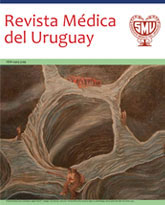Uso prolongado de espaciador en infección de cadera
Nueva modalidad de tratamiento en dos tiempos
Palabras clave:
CEMENTOS PARA HUESOS, INFECCIONES RELACIONADAS CON PRÓTESIS, PRÓTESIS DE CADERAResumen
Objetivo: el tratamiento habitual en la infección protésica es la revisión en dos tiempos. Aquí definimos un nuevo enfoque terapéutico, retrasando el segundo tiempo mientras el espaciador sea útil y permita una buena función clínica. No hemos encontrado en la literatura trabajos que muestren la evolución de espaciadores por tiempo prolongado.
Material y método: se realizó una evaluación retrospectiva de 49 pacientes con infección de cadera que permanecieron con un espaciador artesanal entre uno y nueve años. Del total, dos se perdieron, siete fallecieron, 13 requirieron el segundo tiempo, y 27 de ellos se mantienen con el espaciador, con un promedio de cuatro años.
Resultados: el segundo tiempo fue necesario por rotura de cotilo de cemento (cinco casos), disconfort (cinco casos), y otros en tres casos. En estos hubo dos recidivas de infección a los tres y cinco años de la cirugía. Los 27 casos que se mantienen con el espaciador presentaron una mejoría franca del score clínico en relación al preoperatorio, ninguno de ellos aceptó realizarse el segundo tiempo, y con radiografías que no mostraron alteración del stock óseo en la evolución en ninguno de los casos. Solo en un caso de estos hubo recidiva, diagnosticada al momento de segundo tiempo, donde se realizó un nuevo espaciador.
Conclusiones: la cirugía en dos tiempos es una excelente medida de control de infección y el espaciador realizado logra un resultado clínico tan bueno en el período intermedio que permite postergar el segundo tiempo hasta el momento en que el paciente lo requiere de necesidad, pudiendo llegar a ser definitivo en pacientes muy añosos o terminales.
Citas
(2) Albornoz H, Baldizzoni M, Gambogi R, González M, Scarpitta C. Infección de sitio quirúrgico en artroplastia de cadera por artrosis. Publicación Técnica Nº 4. Montevideo: Fondo Nacional de Recursos, 2008.
(3) Durbhakula SM, Czajka J, Fuchs MD, Uhl RL. Spacer endoprosthesis for the treatment of infected total hip arthroplasty. J Arthroplasty2004; 19(6): 760-7.
(4) Younger AS, Duncan CP, Masri BA, McGraw RW. The outcome of two-stage arthroplasty using a custom-made interval spacer to treat the infected hip. J Arthroplasty 1997; 12(6): 615-23.
(5) Younger AS, Duncan CP, Masri BA. Treatment of infection associated with segmental bone loss in the proximal part of the femur in two stageswith use of an antibiotic-loaded interval prosthesis. J Bone Joint Surg Am 1998; 80(1): 60-9.
(6) Colyer RA, Capello WN. Surgical treatment of the infected hip implant: two-stage reimplantation with a one-month interval. Clin Orthop 1994; 298: 75-9.
(7) Fitzgerald RH Jr, Jones DR. Hip implant infection: treatment with resection arthroplasty and late total hip arthroplasty. Am J Med 1985; 78(6B): 225-8.
(8) Lieberman JR, Callaway GH, Salvati EA, Pellicci PM, Brause BD. Treatment of the infected total hip arthroplasty with a two-stage reimplantation protocol. Clin Orthop 1994; 301: 205-12.
(9) McDonald DJ, Fitzgerald RH Jr, Ilstrup DM. Two-stage reconstruction of a total hip arthroplasty because of infection. J Bone Joint Surg Am 1989; 71(6): 828 -34.
(10) Nelson CL, Evans RP, Blaha JD, Calhoun J, Henry SL, Patzakis MJ. A comparison of gentamicin-impregnated polymethylmethacrylate bead implantation to conventional parenteral antibiotic therapy in infected total hip and knee arthroplasty. Clin Orthop 1993; 295: 96-101.
(11) Etienne G, Waldman B, Rajadhyaksha A, Ragland P, Mont M. Use of a functional temporary prosthesis in a two-stage approach to infection at the site of a total hip arthroplasty. J Bone Joint Surg Am 2003; 85(Suppl 4): 94-6.
(12) Hanssen AD, Spangehl MJ. Treatment of the infected hip replacement. Clin Orthop Relat Res 2004; 420: 63-71.
(13) Toms AD, Davidson D, Masri BA, Duncan CP. The management of peri-prosthetic infection in total joint arthroplasty. J Bone Joint Surg Br 2006; 88(2): 149-55.
(14) Biring GS, Kostamo T, Garbuz DS, Masri BA, Duncan CP. Two-stage revision arthroplasty of the hip for infection using an interim articulated Prostalac hip spacer: a 10 to 15 year follow up study. J Bone Joint Surg Br 2009; 91(11): 1431-7.
(15) D'Aubigne RM, Postel M. Functional results of hip arthroplasty with acrylic prosthesis. J Bone and Joint Surg Am 1954; 36(3): 451-75.
(16) Garvin KL, Hanssen AD. Infection after total hip arthroplasty: past, present, and future. J Bone Joint Surg Am 1995; 77(10): 1576-88.
(17) Buchholz HW, Elson RA, Engelbrecht E, Lodenkämper H, Röttger J, Siegel A. Management of deep infection of total hip replacement. J Bone Joint Surg Br 1981; 63(3): 342-53.
(18) Rudelli S, Uip D, Honda E, Lima AL. One-stage revision of infected total hip arthroplasty with bone graft. J Arthroplasty 2008; 23(8): 1165-77.
(19) Sánchez Sotelo J, Berry DJ, Hanssen AD, Cabanela ME. Midterm to long-term follow up of staged reimplantation for infected hip arthroplasty. Clin Orthop Relat Res 2009; 467(1): 219-24.












